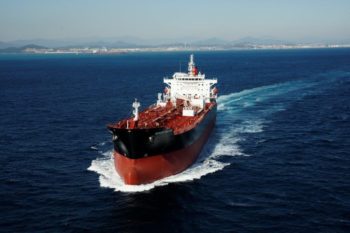
Little more than 2 1/2 years from now, the global fleet of merchant ships will have to reduce drastically how much sulphur their engines belch into the atmosphere. While that will do good things — like diminishing the threat of acid rain and helping asthma sufferers — there’s a $60 billion sting in the tail.
That’s how much more seaborne vessels may be forced to spend each year on higher-quality fuel to comply with new emission rules that start in 2020, consultant Wood Mackenzie Ltd. estimates. For an industry that hauls everything from oil to steel to coal, higher operating costs will compound the financial strain on cash-strapped ship owners, whose vessels earn an average of 70 percent less than they did just before the 2008-09 recession.
The consequences may reach beyond the 90,000-ship merchant fleet, which handles about 90 percent of global trade. Possible confusion over which carriers comply with the new rules could lead to some vessels being barred from making deliveries, which would disrupt shipments, according to BIMCO, a group representing ship owners and operators in about 130 countries. Oil refiners still don’t have enough capacity to supply all the fuel that would be needed, and few vessels have embarked on costly retrofits.
“There will be an absolute chaos,” said Lars Robert Pedersen, the deputy secretary general of Denmark-based BIMCO. “We are talking about 2.5 million to 4 million barrels a day of fuel oil to basically shift into a different product.”
Merchant ships around the world are required to cut the amount of sulphur emitted under rules approved in October by the International Maritime Organization, a UN agency that sets industry standards for safety, security and the environment. As well as contributing to acid rain, sulphur, combined with oxygen, can form fine sulphate particles that can be inhaled by humans and may cause asthma and bronchitis, according to the U.S. Environmental Protection Agency.
There are two main ways to comply: vessel engines are fitted with scrubbers that would eliminate the pollutant, or oil refiners will have to make lower-emission fuels. The limit on sulphur content will drop to 0.5 percent from 3.5 percent.
So far, neither the refining industry nor shipping is doing anywhere near enough for owners to achieve compliance in 2020, according Iain Mowat, a senior analyst at Wood Mackenzie.
“Ship owners are reluctant to install scrubbers to continue using the same oil because of uncertainties and lack of funding,” Mowat said. “And most refineries won’t invest to convert heavy fuel because that will cost more than $1 billion and take about five years to complete.”
Just 2.2 percent of the fleet will have scrubbers installed by 2020 that would allow them to continue using current fuels, estimates the International Energy Agency in Paris, an adviser to 29 nations.
“The compliant technical options are still very immature, and it is hard for us to see them as a real compliance option for our fleet,” said Aslak Ross, head of marine standards at Maersk Line, the world’s biggest container shipping company. For Maersk alone, the additional fuel cost will amount to billions of dollars annually, he said.
Most ships will switch to using a mix of lower-sulphur fuel oil or more-expensive middle distillates, according to Jan Christensen, head of global bunker operations at Bomin Bunker Holding, a Hamburg, Germany-based fuels supplier.
The scrubbing technology could cost as much as $4 million per engine, depending on its size, said Nick Confuorto, president and chief operating officer at scrubber supplier CR Ocean Engineering. Retrofitting engines might be worth doing, possibly paying off in two years, because the price of compliant fuel probably will be three times higher than what ships currently burn, he said.
While the world’s largest owners are already reserving spaces for refits, smaller operators are taking a more wait-and-see approach, said Neil Carmichael, chief executive officer at Pacific Green Technologies.
Wood Mackenzie estimates about 70 percent compliance globally by 2020 and full compliance by 2025 after a transition period.
Merchant ships earned an average of about $9,800 a day this year, according to data from Clarkson Research Services Ltd., part of the world’s biggest shipbroker. Ten years ago, they were earning about $34,000. In the industry’s three main markets — container shipping, dry-bulk cargo transportation, and oil tankers — there’s been evidence of overcapacity and depressed rates over the past several years.
Those tough markets are making it harder for owners to secure investment and finance they need to comply, which means the IMO and its member states will probably permit some kind of transition period when the 2020 rules begin, Simon Bennett, policy director and external relations at the International Chamber of Shipping, said in a phone interview.
“If there were no flexibility on Jan. 1 and owners couldn’t get fuel, then that would have an impact on world trade,” Bennett said. Either way, “this will have a profound impact on the economics of shipping.”